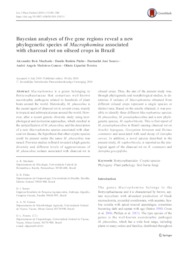Bayesian analyses of five gene regions reveal a new phylogenetic species of Macrophomina associated with charcoal rot on oilseed crops in Brazil.
Bayesian analyses of five gene regions reveal a new phylogenetic species of Macrophomina associated with charcoal rot on oilseed crops in Brazil.
Author(s): MACHADO, A. R.; PINHO, D. B.; SOARES, D. J.; GOMES, A. A. M.; PEREIRA, O. L.
Summary: Macrophomina is a genus belonging to Botryosphaeriaceae that comprises well-known necrotrophic pathogens related to hundreds of plant hosts around the world. Historically, M. phaseolina is the causal agent of charcoal rot in several crops, mainly in tropical and subtropical areas around the world. However, after a recent genetic diversity study using morphological and molecular approaches, which resulted in the epitypification of M. phaseolina, and the description of a new Macrophomina species associated with charcoal rot disease, the hypothesis that other cryptic species could be present under the name M. phaseolina was raised. Previous studies in Brazil revealed a high genetic diversity and different levels of aggressiveness of M. phaseolina isolates associated with charcoal rot in oilseed crops. Thus, the aim of the present study was, through phylogenetic and morphological studies, to determine if isolates of Macrophomina obtained from different oilseed crops represent a single species or distinct taxa. Based on the results obtained, it was possible to identify three different Macrophomina species: M. phaseolina, M. pseudophaseolina and a new phylogenetic species, M. euphorbiicola. This is first report of M. pseudophaseolina in Brazil causing charcoal rot on Arachis hypogaea, Gossypium hirsutum and Ricinus communis and associated with seed decay of Jatropha curcas. In addition, a novel species described in the present study, M. euphorbiicola, is reported as the etiological agent of the charcoal rot on R. communis and Jatropha gossypifolia.
Publication year: 2019
Types of publication: Journal article
Unit: Embrapa Cotton
Keywords: Botryosphaeriales, Cryptic species, Phylogeny, Plant pathology, Soil-borne fungi
Observation
Some of Embrapa's publications are published as ePub files. To read them, use or download one of the following free software options to your computer or mobile device. Android: Google Play Books; IOS: iBooks; Windows and Linux: Calibre.
Access other publications
Access the Agricultural Research Database (BDPA) to consult Embrapa's full library collection and records.
Visit Embrapa Bookstore to purchase books and other publications sold by Embrapa.

